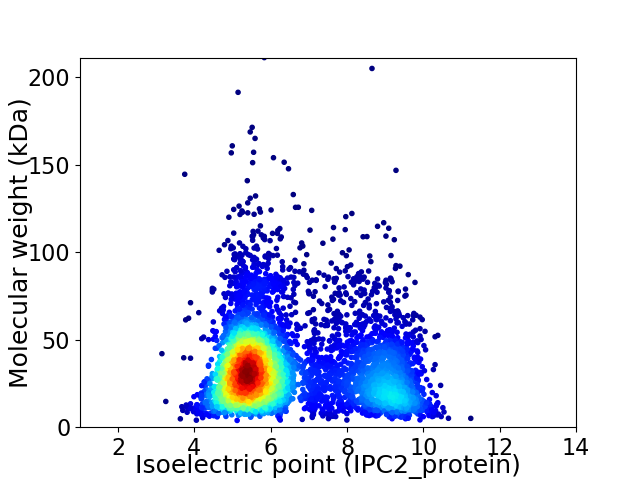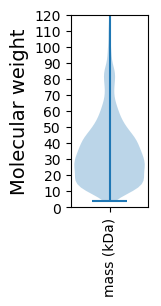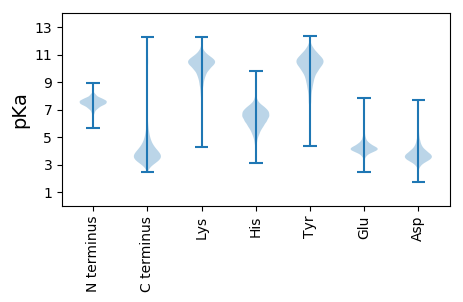
Sphingomonas wittichii (strain RW1 / DSM 6014 / JCM 10273)
Taxonomy: cellular organisms; Bacteria; Proteobacteria; Alphaproteobacteria; Sphingomonadales; Sphingomonadaceae; Sphingomonas; Sphingomonas wittichii
Average proteome isoelectric point is 6.52
Get precalculated fractions of proteins

Virtual 2D-PAGE plot for 5313 proteins (isoelectric point calculated using IPC2_protein)
Get csv file with sequences according to given criteria:
* You can choose from 21 different methods for calculating isoelectric point
Summary statistics related to proteome-wise predictions



Protein with the lowest isoelectric point:
>tr|A5V4X8|A5V4X8_SPHWW Catechol 1 2-dioxygenase OS=Sphingomonas wittichii (strain RW1 / DSM 6014 / JCM 10273) OX=392499 GN=Swit_0977 PE=3 SV=1
MM1 pKa = 7.9TIRR4 pKa = 11.84LCATDD9 pKa = 5.74DD10 pKa = 3.56IPEE13 pKa = 4.39GEE15 pKa = 4.32VRR17 pKa = 11.84QFAVDD22 pKa = 3.63DD23 pKa = 4.15GRR25 pKa = 11.84TLAVYY30 pKa = 10.0RR31 pKa = 11.84VDD33 pKa = 3.25GDD35 pKa = 3.91YY36 pKa = 10.93FATDD40 pKa = 3.97DD41 pKa = 4.3LCTHH45 pKa = 6.85GDD47 pKa = 3.27ASLSEE52 pKa = 4.4GEE54 pKa = 4.39IEE56 pKa = 5.33DD57 pKa = 4.63GKK59 pKa = 10.77ILCPYY64 pKa = 10.28HH65 pKa = 6.5MGSFDD70 pKa = 3.12IRR72 pKa = 11.84TGEE75 pKa = 3.88ACAAPCSIAIKK86 pKa = 9.01TYY88 pKa = 10.44RR89 pKa = 11.84LAVDD93 pKa = 3.86GDD95 pKa = 4.23DD96 pKa = 5.25VLLLDD101 pKa = 4.44
MM1 pKa = 7.9TIRR4 pKa = 11.84LCATDD9 pKa = 5.74DD10 pKa = 3.56IPEE13 pKa = 4.39GEE15 pKa = 4.32VRR17 pKa = 11.84QFAVDD22 pKa = 3.63DD23 pKa = 4.15GRR25 pKa = 11.84TLAVYY30 pKa = 10.0RR31 pKa = 11.84VDD33 pKa = 3.25GDD35 pKa = 3.91YY36 pKa = 10.93FATDD40 pKa = 3.97DD41 pKa = 4.3LCTHH45 pKa = 6.85GDD47 pKa = 3.27ASLSEE52 pKa = 4.4GEE54 pKa = 4.39IEE56 pKa = 5.33DD57 pKa = 4.63GKK59 pKa = 10.77ILCPYY64 pKa = 10.28HH65 pKa = 6.5MGSFDD70 pKa = 3.12IRR72 pKa = 11.84TGEE75 pKa = 3.88ACAAPCSIAIKK86 pKa = 9.01TYY88 pKa = 10.44RR89 pKa = 11.84LAVDD93 pKa = 3.86GDD95 pKa = 4.23DD96 pKa = 5.25VLLLDD101 pKa = 4.44
Molecular weight: 10.96 kDa
Isoelectric point according different methods:
Protein with the highest isoelectric point:
>tr|A5VCJ4|A5VCJ4_SPHWW 2-octaprenyl-3-methyl-6-methoxy-1 4-benzoquinol hydroxylase OS=Sphingomonas wittichii (strain RW1 / DSM 6014 / JCM 10273) OX=392499 GN=Swit_3664 PE=3 SV=1
MM1 pKa = 7.45KK2 pKa = 9.61RR3 pKa = 11.84TFQPSNLVRR12 pKa = 11.84KK13 pKa = 8.96RR14 pKa = 11.84RR15 pKa = 11.84HH16 pKa = 4.61GFRR19 pKa = 11.84SRR21 pKa = 11.84SATPGGRR28 pKa = 11.84KK29 pKa = 9.04VLAARR34 pKa = 11.84RR35 pKa = 11.84ARR37 pKa = 11.84GRR39 pKa = 11.84KK40 pKa = 9.02KK41 pKa = 10.61LSAA44 pKa = 4.03
MM1 pKa = 7.45KK2 pKa = 9.61RR3 pKa = 11.84TFQPSNLVRR12 pKa = 11.84KK13 pKa = 8.96RR14 pKa = 11.84RR15 pKa = 11.84HH16 pKa = 4.61GFRR19 pKa = 11.84SRR21 pKa = 11.84SATPGGRR28 pKa = 11.84KK29 pKa = 9.04VLAARR34 pKa = 11.84RR35 pKa = 11.84ARR37 pKa = 11.84GRR39 pKa = 11.84KK40 pKa = 9.02KK41 pKa = 10.61LSAA44 pKa = 4.03
Molecular weight: 5.05 kDa
Isoelectric point according different methods:
Peptides (in silico digests for buttom-up proteomics)
Below you can find in silico digests of the whole proteome with Trypsin, Chymotrypsin, Trypsin+LysC, LysN, ArgC proteases suitable for different mass spec machines.| Try ESI |
 |
|---|
| ChTry ESI |
 |
|---|
| ArgC ESI |
 |
|---|
| LysN ESI |
 |
|---|
| TryLysC ESI |
 |
|---|
| Try MALDI |
 |
|---|
| ChTry MALDI |
 |
|---|
| ArgC MALDI |
 |
|---|
| LysN MALDI |
 |
|---|
| TryLysC MALDI |
 |
|---|
| Try LTQ |
 |
|---|
| ChTry LTQ |
 |
|---|
| ArgC LTQ |
 |
|---|
| LysN LTQ |
 |
|---|
| TryLysC LTQ |
 |
|---|
| Try MSlow |
 |
|---|
| ChTry MSlow |
 |
|---|
| ArgC MSlow |
 |
|---|
| LysN MSlow |
 |
|---|
| TryLysC MSlow |
 |
|---|
| Try MShigh |
 |
|---|
| ChTry MShigh |
 |
|---|
| ArgC MShigh |
 |
|---|
| LysN MShigh |
 |
|---|
| TryLysC MShigh |
 |
|---|
General Statistics
Number of major isoforms |
Number of additional isoforms |
Number of all proteins |
Number of amino acids |
Min. Seq. Length |
Max. Seq. Length |
Avg. Seq. Length |
Avg. Mol. Weight |
|---|---|---|---|---|---|---|---|
0 |
1783296 |
33 |
1934 |
335.6 |
36.25 |
Amino acid frequency
Ala |
Cys |
Asp |
Glu |
Phe |
Gly |
His |
Ile |
Lys |
Leu |
|---|---|---|---|---|---|---|---|---|---|
13.585 ± 0.05 | 0.81 ± 0.01 |
6.185 ± 0.025 | 5.259 ± 0.032 |
3.559 ± 0.019 | 9.17 ± 0.037 |
2.074 ± 0.016 | 5.059 ± 0.021 |
2.661 ± 0.024 | 9.813 ± 0.04 |
Met |
Asn |
Gln |
Pro |
Arg |
Ser |
Thr |
Val |
Trp |
Tyr |
|---|---|---|---|---|---|---|---|---|---|
2.372 ± 0.015 | 2.339 ± 0.023 |
5.53 ± 0.025 | 2.9 ± 0.018 |
7.92 ± 0.034 | 5.08 ± 0.026 |
4.962 ± 0.023 | 7.05 ± 0.025 |
1.39 ± 0.013 | 2.283 ± 0.02 |
Most of the basic statistics you can see at this page can be downloaded from this CSV file
Proteome-pI is available under Creative Commons Attribution-NoDerivs license, for more details see here
| Reference: Kozlowski LP. Proteome-pI 2.0: Proteome Isoelectric Point Database Update. Nucleic Acids Res. 2021, doi: 10.1093/nar/gkab944 | Contact: Lukasz P. Kozlowski |
